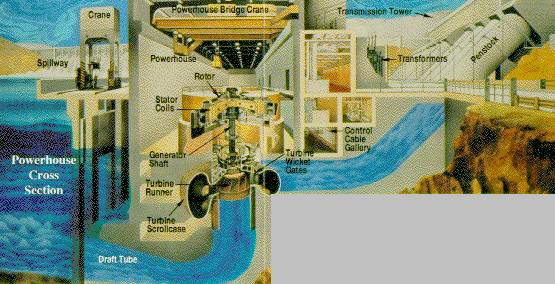
Hydropower converts the energy of flowing water into electricity. The amount of electricity generated is determined by the volume of water and the amount of "head" (the height from the turbines in the powerplant to the water surface) created by the dam. The greater the flow and head, the more electricity is produced.
Chief Joseph Dam holds back the Columbia River, creating a head of 178 feet. Penstocks carry water from Rufus Woods Lake to turbines inside the powerhouse. As the water falls through a penstock it rotates a turbine, causing the rotor to spin. The rotor has magnetic poles, which generate electricity when they spin around the copper windings in the generator's stator.
The electricity created is rated at 13,800 volts. It is then converted to 230,000 volts or 540,000 volts in order to reduce transmission line power losses. Initially it is carried to the Bonneville Power Administration (BPA) switchyard near the dam.
BPA distributes and sells electricity produced at federal power plants in the Northwest to public and private utilities. Eighty percent of the power generated at Chief Joseph Dam is sent to the Everett area north of Seattle. Power produced at the dam is not only used in Washington, but also in Oregon, Montana, Idaho, California, Wyoming, Utah and Nevada.
Water behind the dam flows through huge penstocks (pipes) down to the turbines in the powerhouse. Moving at high velocity, the water strikes the turbine runner blades causing the runner to turn, spinning a steel shaft that turns the generator's rotor. Large electromagnets are located around the outside of the wheel-like rotor frame. As the rotor turns, the electromagnets establish an alternating magnetic field that penetrates the stationary copper conductors in the coils of the generator stator. As the individual copper conductors in the coils are subjected to the alternating magnetic field, electrical energy is produced.